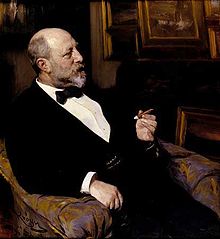Heinrich Hirschsprung
Heinrich Hirschsprung ( February 7, 1836 in Copenhagen - November 8, 1908 there ) was a Danish entrepreneur, art patron and art collector . The tobacco and cigar manufacturer was the founder and namesake of the art museum Den Hirschsprungske Samling in Copenhagen.
Life
Heinrich Hirschsprung came from a family with Jewish-German roots. He was a son of Abraham Marcus Hirschsprung (1793-1871) from Friedberg near Frankfurt am Main , who had settled in Denmark in 1826 and founded a tobacco trade. In 1858 Heinrich and his brother Bernhard (1834–1909) took over the management of the company and expanded it to AM Hirschsprung & Sønner , specializing in the manufacture of cigars. While Bernhard was responsible for production, Heinrich was responsible for the commercial part of the company. Heinrich Hirschsprung married Pauline Elisabeth, born on June 26, 1864. Jacobson (1845-1912).
Hirschsprung began collecting art in 1866. His first purchase was a painting by Julius Exner : Lille pige, der lader en gammel mand lugte til en blomst (Little girl who lets an old man smell a flower). Over the years, numerous acquisitions resulted in a private collection in which all well-known Danish artists and art movements were represented. For the Golden Age , these were paintings by Christoffer Wilhelm Eckersberg , Johan Thomas Lundbye , Wilhelm Bendz or PC Skovgaard that were purchased in the 1870s . His advisors and friends included the painters Frederik Vermehren and Otto Bache (1839–1927) and the art historian Julius Henrik Lange , and Vilhelm Marstrand was one of his advisors.
While in 1877 a heated debate began in the Danish art scene about the orientation of national versus international and especially French art, Hirschsprung stood on the international side. In the same year he organized an exhibition of modern French art in Copenhagen and supported several artists with travel grants to visit the World Exhibition in Paris in 1878. His work as an art patron was particularly evident at PS Krøyer, whose talent he had recognized and which he had financially promoted during his trips abroad in the years 1877 to 1881. The stays abroad led to Krøyer's international breakthrough and his work contributed to the transition to realism in Danish art. Krøyer became friends with the whole family. Long-standing personal correspondence with Pauline Hirschsprung and a number of family portraits are evidence of this, as are the numerous works by Krøyer in the collection.
At the end of the 19th century, the works of the Skagen painters and symbolists were added. a. Erik Henningsen , Lauritz Andersen Ring , Joakim Skovgaard , Anna Ancher , Michael Ancher , Laurits Tuxen and PS Krøyer.
In 1888 Hirschsprung was asked to show his collection in an exhibition at Charlottenborg Palace ; the catalog included 313 titles. Around 60 artists were represented; in addition to around 150 paintings, watercolors, pastels, drawings and sculptures were on display. In the 1890s, the idea of transferring the collection into public ownership came up. The acquaintance with the art historian Emil Hannover (1864–1923) led to the collection being geared towards future museum use and the purchase of important works.
In 1900 Heinrich and Pauline Hirschsprung deposited a deed of foundation for the collection with the Danish Ministry of Culture and began discreet negotiations with the state and local authorities. While the collection was shown again in an exhibition at Charlottenborg in 1902, Hirschsprung felt it was time to make the donation public. At that time the collection comprised 1,980 items, including approx. 500 oil paintings, a large number of watercolors and drawings, and approx. 200 sculptures.
"Mr. Rentier Heinrich Hirschsprung will transfer his extremely rich collection of paintings to the state by only stipulating that a suitable museum building is set up for it." The conditions could only be met in 1907 through lengthy debates. The founder did not live to see the opening, which took place in the presence of his widow on July 8, 1911.
Heinrich Hirschsprung was buried in the Jewish cemetery Mosaisk Vestre begravelsesplads in Copenhagen .
family
Heinrich Hirschsprung's wife Pauline came from the wealthy Jewish family of the wholesaler Daniel Simon Jacobson (1791–1858) and Frederikke, nee. Gerhardt (1811-1855). The Hirschsprungs had five children: four sons Robert Daniel (1865–1889), Oscar Heinrich (1867–1945), Ivar Lykke (1868–1894) and Einar Aage (1869–1909) and their daughter Ellen Frederikke (1870–1948) . The pediatrician Harald Hirschsprung was Heinrich's oldest brother.
literature
- Hirschsprung, Heinrich. at Gyldendals Den Store Danske
- Hirschsprung, Heinrich . In: Theodor Westrin (Ed.): Nordisk familjebok konversationslexikon och realencyklopedi . 2nd Edition. tape 11 : Harrisburg – Hypereides . Nordisk familjeboks förlag, Stockholm 1909, Sp. 751 (Swedish, runeberg.org ).
- HR Baumann: Hirschsprung, Heinrich . In: Carl Frederik Bricka (Ed.): Dansk biografisk Lexikon. Tillige omfattende Norge for Tidsrummet 1537-1814. 1st edition. tape 7 : I. Hansen – Holmsted . Gyldendalske Boghandels Forlag, Copenhagen 1893, p. 457-458 (Danish, runeberg.org ).
Web links
- The Hirschsprungske Samling website
- Hirschsprungske Samling, Den, Stockholmsgade. Selskabet for København's history
- Hirschsprung, Heinrich. at gravsted.dk (Danish)
Individual evidence
- ↑ a b c Hirschsprung history. ( Memento from January 25, 2017 in the Internet Archive ) The Hirschsprungske Samling
- ↑ Hirschsprung, Heinrich . In: Theodor Westrin (Ed.): Nordisk familjebok konversationslexikon och realencyklopedi . 2nd Edition. tape 11 : Harrisburg – Hypereides . Nordisk familjeboks förlag, Stockholm 1909, Sp. 751 (Swedish, runeberg.org ).
- ^ Sigurd Müller : Collections and exhibitions. In: Kunstchronik: Wochenschrift für Kunst und Kunstgewerbe , NF 14, Issue 5, Nov. 6, 1902, p. 81 ( uni-heidelberg.de ).
| personal data | |
|---|---|
| SURNAME | Hirschsprung, Heinrich |
| BRIEF DESCRIPTION | Danish entrepreneur, art patron and art collector |
| DATE OF BIRTH | February 7, 1836 |
| PLACE OF BIRTH | Copenhagen |
| DATE OF DEATH | November 8, 1908 |
| Place of death | Copenhagen |


